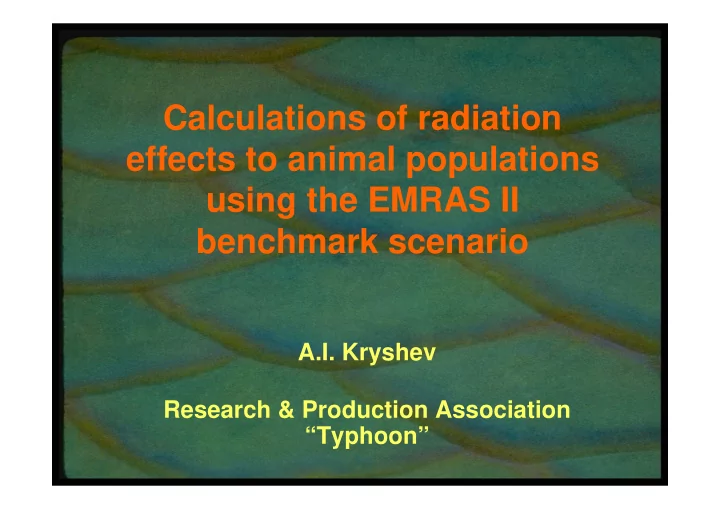

Calculations of radiation effects to animal populations using the EMRAS II benchmark scenario A.I. Kryshev Research & Production Association “Typhoon”
The objective of the study was application of the model, which simulates the development of radiation effects in an isolated, chronically exposed population to the EMRAS II benchmark scenario. The following species were considered: mouse, rabbit, wolf
The following endpoints were taken into consideration: Decrease of population number from the initial size (1000) after 1, 2, 3, 4, 5 years of chronic exposure with dose rates 10, 20, 30, 40, 50 mGy/day Decrease of reproduction capacity (in %) after 5 years of chronic exposure
The effects caused by chronic irradiation in population are considered to be a result of superposition of three major processes – creation of damage by radiation, recovery of damage by means of repairing mechanisms, natural growth of population
An isolated generic population has been modelled, living under ideal conditions (no predators, no limitation by food, optimal temperature and other environmental factors), which is exposed to chronic ionizing radiation with a dose rate p (mGy/day)
We assume, that organisms composing the exposed population may be in one of the following states: undamaged, reversibly damaged, lethally damaged
Reversible damages are recovered by the repairing mechanisms, the repairing pool is spent for the repairing processes. Effect on morbidity of organisms in the population depends on decrease of the repairing pool (in % from its initial value). The ionizing radiation also cause a direct damage to the repairing pool itself.
Reproduction system increases number of normal organisms in the population, but itself is affected by the ionizing radiation
A system of differential equations describing the effects of chronic radiation exposure on fish population can be written as: dx px yR ( x x ) F max dt dy px y yR dt dR R R R yR p R ( ) r max r r dt dF p F F ( x x ) F ( F F ) f f max max dt x ( 0 ) x ; y ( 0 ) 0 ; R ( 0 ) R ; F ( 0 ) F max max max
Parameter of radiation damage: =ln2/LD50, where LD50=6.2 Gy (mouse); 7.25 Gy (rabbit); 2.75 Gy (dog/wolf) (estimates was taken from Blend M.J. Course notes in medical radiation biology. University of Illinois at Chicago. www.uic.edu/com/uhrd/manual/se ction4/section4.html)
Population survival at different dose rates, 5 years Mouse 1000 Rabbit 900 Wolf 800 700 Number of animals 600 500 400 300 200 100 0 0 10 20 30 40 50 Dose rate, mGy/day
Reproduction capacity of populations Mouse Rabbit 1 Wolf 0,9 0,8 0,7 Part of control 0,6 0,5 0,4 0,3 0,2 0,1 0 0 10 20 30 40 50 Dose rate, mGy/day
Recommend
More recommend